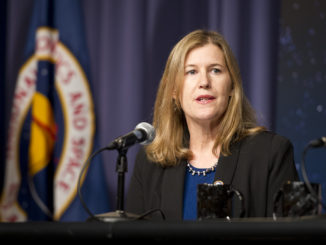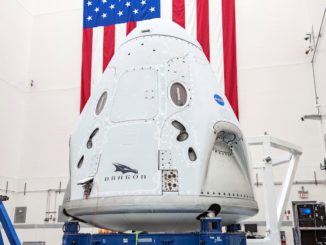
NASA and Orbital ATK have agreed to schedule the launch of the next Cygnus supply ship for Nov. 10 from Wallops Island on Virginia’s Eastern Shore, a delay of a month from the mission’s earlier target launch date to allow the flight to carry more cargo to the International Space Station, officials said.
The new launch date also will allow time for station astronauts to complete three spacewalks in late October and early November to swap out a latching end effector on the station’s Canadian-built robotic arm and complete other maintenance tasks, according to Dan Hartman, NASA’s deputy space station program manager.
If the Nov. 10 date holds, liftoff of the automated cargo mission on top of an Antares rocket will occur around 8:02 a.m. EST (1302 GMT), roughly the moment Earth’s rotation brings the Wallops launch base in the flight path of the space station, according to an Orbital ATK spokesperson.
“With the slip of one month, we’re able to get new cargo that we need up to the station, on the order of about 400 kilograms (880 pounds),” Hartman said Sunday. “So a significant increase in the amount of mass we can take up.”
Some specific items NASA wants delivered to the space station would not have been ready in time for the previous Oct. 11 launch date.
The next mission by NASA’s other cargo delivery provider, SpaceX, will slip from early November to early December in the schedule shuffle. SpaceX’s latest cargo flight arrived at the space station Wednesday, two days after launching from NASA’s Kennedy Space Center in Florida.
Orbital ATK said in a statement that the delay of the next Cygnus cargo mission, named OA-8, was decided by NASA and was “solely based on NASA’s revised ISS traffic planning and cargo needs.”
The flight will ferry experiments, supplies and spare parts to the space station.
“Integration and test of the Antares launch vehicle and Cygnus spacecraft are complete and both were processed to support a mission as early as September of this year,” Orbital ATK said. “Final preparations for the mission will begin in early October to support the new November 10 target launch date.”

The mission will be the Orbital ATK’s eighth operational logistics flight to the space station, and the fifth to lift off from Wallops on the company’s own Antares booster. Three others flew on United Launch Alliance Atlas 5 rockets from Cape Canaveral.
Hartman said the space station has plenty of supplies, and the delays of the next two U.S. cargo flights will have no impact to the research lab’s operations.
“Our consumables are in very, very good shape on-board the International Space Station,” Hartman said. “So the slip there will have absolutely no impact to a crew of four,” he said, referring to the four astronauts from NASA and the European Space Agency who are part of the outpost’s overall six-person crew.
NASA managers recently approved a plan to conduct three spacewalks in late October and early November, Hartman said.
Astronauts will replace a latching end effector on the space station’s 58-foot-long Canadian-built robotic arm during the excursions. Engineers have noticed some fraying on wires inside the end of the arm, components used to grasp cargo ships as they arrive at the space station and transfer experiments and payloads around the outside of the complex, Hartman said.
The spacewalkers will also change out lights and cameras outside the space station.
Meanwhile, Russian cosmonauts Fyodor Yurchikhin and Sergey Ryazanskiy planned to head outside the station Thursday to release five small satellites and work on experiments on the outside of the Russian segment of the complex.
Yurchikhin will be joined by NASA astronauts Peggy Whitson and Jack Fischer for return to Earth on Sept. 2. Three fresh crew members will launch on a new Soyuz spaceship Sept. 12 from the Baikonur Cosmodrome in Kazakhstan.
A Russian Progress cargo and refueling freighter will launch Oct. 12 from Baikonur, followed by the next Orbital ATK and SpaceX resupply runs in November and December.
Email the author.
Follow Stephen Clark on Twitter: @StephenClark1.



